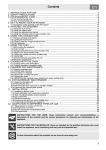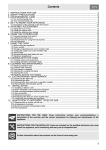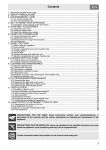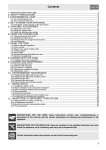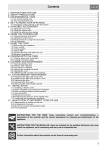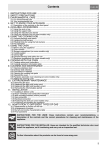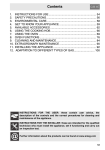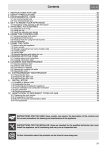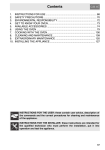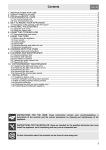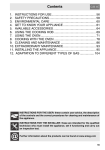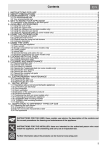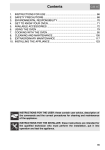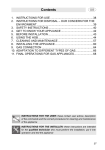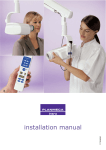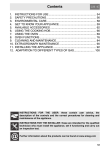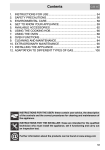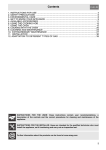Download Smeg CC92MX9 cooker
Transcript
Contents 1. INSTRUCTIONS FOR USE ..................................................................................................... 4 2. SAFETY PRECAUTIONS ........................................................................................................ 6 3. ENVIRONMENTAL CARE ....................................................................................................... 8 3.1 Our environmental care .................................................................................................................................. 8 3.2 Your environmental care ................................................................................................................................. 8 4. GET TO KNOW YOUR APPLIANCE ....................................................................................... 9 4.1 Description of the controls on the front panel ............................................................................................... 10 5. AVAILABLE ACCESSORIES ................................................................................................. 11 5.1 Using the rack or tray .................................................................................................................................... 12 5.2 Using the support rack .................................................................................................................................. 12 5.3 Using the reduction pan stands .................................................................................................................... 12 6. USING THE COOKING HOB ................................................................................................. 13 6.1 General warnings and advice ....................................................................................................................... 13 6.2 Lighting the hob burners ............................................................................................................................... 13 6.3 Practical hints for using the hob burners ....................................................................................................... 13 6.4 Pan diameters ............................................................................................................................................... 14 7. USING THE OVEN ................................................................................................................ 15 7.1 Before using the appliance ........................................................................................................................... 15 7.2 Oven runners ................................................................................................................................................ 15 7.3 Storage compartment (on some models only) .............................................................................................. 15 7.4 Glass lid (on some models only) ................................................................................................................... 16 7.5 Cooling system ............................................................................................................................................. 16 7.6 Internal light .................................................................................................................................................. 16 7.7 General warnings and advice for use ........................................................................................................... 17 7.8 Electronic programmer (on some models only) ............................................................................................ 18 8. COOKING WITH THE OVEN ................................................................................................ 20 8.1 Cooking advice and instructions ................................................................................................................... 21 8.2 Cooking operation information table ............................................................................................................. 22 9. CLEANING AND MAINTENANCE ......................................................................................... 23 9.1 Cleaning stainless steel ................................................................................................................................ 23 9.2 Ordinary daily cleaning ................................................................................................................................. 23 9.3 Food stains or residues ................................................................................................................................. 23 9.4 Cleaning the cooking hob parts .................................................................................................................... 23 9.5 Cleaning the oven ......................................................................................................................................... 25 9.6 VAPOR CLEAN: assisted oven cleaning (on some models only) ................................................................. 26 10. EXTRAORDINARY MAINTENANCE .................................................................................. 28 10.1 Replacing the light bulb (main oven) ........................................................................................................... 28 10.2 Replacing the light bulb (auxiliary oven) ..................................................................................................... 28 10.3 Removing the door ...................................................................................................................................... 29 10.4 Removing the door seal (not on pyrolitic models) ....................................................................................... 29 10.5 Removing the internal glass panels ............................................................................................................ 30 11. INSTALLATION .................................................................................................................. 31 11.1 Installing in kitchen units ............................................................................................................................. 31 11.2 Room ventilation and combustion extraction .............................................................................................. 32 11.3 Wall mounting brackets (where present) ..................................................................................................... 33 11.4 Gas connection ........................................................................................................................................... 34 11.5 Electrical connection ................................................................................................................................... 36 11.6 Positioning the skirt (on some models only) ................................................................................................ 37 11.7 Positioning and levelling the appliance ....................................................................................................... 37 12. ADAPTATION TO DIFFERENT TYPES OF GAS .............................................................. 38 12.1 Replacement of nozzles on the hob ............................................................................................................ 38 12.2 Arrangement of burners .............................................................................................................................. 38 12.3 Burner and nozzle characteristics table ...................................................................................................... 39 12.4 Final operations .......................................................................................................................................... 39 INSTRUCTIONS FOR THE USER: these instructions contain user recommendations, a description of the controls and the correct procedures for cleaning and maintenance of the appliance. INSTRUCTIONS FOR THE INSTALLER: these are intended for the qualified technician who must install the appliance, set it functioning and carry out an inspection test. @ Further information about the products can be found at www.smeg.com 3 General instructions 1. INSTRUCTIONS FOR USE This manual is an integral part of the appliance. It must be kept in its entirety and in an accessible place for the whole working life of the appliance. We recommend reading this manual and all the information it contains carefully before using the appliance. Installation must be carried out by qualified personnel in accordance with the standards in force. This appliance is intended for domestic use and conforms to the EC directives currently in force. The appliance has been built to carry out the following functions: cooking and heating up food; all other uses are considered unsuitable. These instructions are valid only for the destination countries whose identifying symbols are included on the cover of this manual. Never obstruct the openings and slits provided for ventilation and heat dispersal; this may cause malfunctions. Do not use this appliance for heating rooms. This appliance is marked according to European directive 2002/96/EC on Waste Electrical and Electronic Equipment (WEEE). This directive defines the standards for the collection and recycling of waste electrical and electronic equipment applicable throughout the European union. The identification plate with technical data, serial number and brand name is located in an exposed position either in the drawer (where present) or on the back of the appliance. A copy of the identification plate is included in the booklet. It should be applied to the appropriate space on the back of the cover. Do not remove this plate for any reason. Before the appliance is put into operation, all labels and protective films applied on external surfaces must be removed. Do not use metallic sponges or sharp scrapers: they will damage the surfaces. Use normal non-abrasive products and a wooden or plastic tool if necessary. Rinse thoroughly and dry using a soft cloth. Do not allow residues of sugary foods (such as jam) to set inside the oven. If left to set for too long, they might damage the enamel lining of the oven. Do not use plastic kitchenware or containers. The high temperatures inside the oven could melt the plastic, damaging the appliance. Always check that the control knobs are in the “zero” (off) position when you finish using the appliance. Do not use sealed tins or containers in the appliance. Overpressure may occur inside the containers during cooking, creating a danger of explosion. Do not cover the bottom of the oven with aluminium or tinfoil sheets during cooking and do not place pans or trays on it to avoid damage to the enamelled surface. Never place saucepans with bases which are not perfectly flat and smooth on the hob. Unstable cookware can lead to scalding. Do not rest any weight or sit on the open door of the appliance. Excessive weight may jeopardise its stability. 4 General instructions The appliance becomes very hot during use. Suitable heat-proof gloves should be worn for all operations. Do not use the hob if pyrolysis (where present) is taking place inside the oven. If you intend to go away for a prolonged period of time, close the mains gas tap or the gas cylinder tap. Take care that no objects are stuck in the door of the oven. Do not open the storage compartment (where present) when the oven is on and still hot. The temperatures inside it may be very high. If the surfaces are still very hot during cooking, do not pour water directly onto the trays. The steam could cause severe burns and damage enamelled surfaces. All cooking operations must take place with the door closed. The dissipation of heat may cause hazards. The manufacturer declines all responsibility for damage to persons or things caused by nonobservance of the above prescriptions or by interference with any part of the appliance or by the use of non-original spare parts. 5 General instructions 2. SAFETY PRECAUTIONS Consult the installation instructions for safety standards on electrical or gas appliances and for ventilation functions. In your interests and for your safety the law requires that the installation and servicing of all electrical and gas appliances be carried out by qualified personnel in accordance with the standards in force. Our approved installers guarantee a satisfactory job. Gas or electrical appliances must always be uninstalled by suitably skilled people. Before connecting the appliance to the power grid, check the data on the plate against the data for the grid itself. If the appliance is installed on a raised platform, secure it using suitable fastening devices. Before carrying out installation/maintenance work, make sure that the appliance is disconnected from the power grid. If the cooking appliances are installed in motor vehicles (for example, camper vans, caravans etc.), they must only be used when the vehicle is stationary. Install the appliance so that when opening the drawers or doors of units positioned at the level of the hob there is no possibility of making contact with pans positioned on top of it. Immediately after installation, carry out a quick test on the appliance following the instructions provided later in this manual. Should the appliance not function, disconnect it from the power supply and call the nearest technical assistance centre. The plug to be connected to the power supply cable and its socket must be of the same type and conform to the standards in force. The socket must be accessible after the appliance has been installed. Never disconnect the plug by pulling on the cable. If the power supply cable is damaged, contact the technical support service immediately and they will replace it. The appliance must be connected to earth in compliance with electrical system safety standards. During use the appliance and its accessible parts become very hot. Take care never to touch the heating elements. Keep children younger than 8 away from the appliance, unless under continuous supervision. Never put inflammable objects in the oven: they could be accidentally ignited and cause fires. The appliance is intended for use by adults. Do not allow children to go near it or play with it. This appliance may be used by children from the age of 8 and by people of reduced physical and mental ability or lacking in experience and knowledge, provided they are supervised or instructed on the safe use of the appliance and if they understand the associated risks. Do not allow children to play with the appliance. Do not allow unsupervised children to perform cleaning or maintenance operations. Never attempt to repair the appliance. All repairs must be carried out by an authorised technician or at an authorised service centre. The improper use of tools can cause hazards. This appliance must not be controlled using an external timer or remote control system. 6 General instructions Be aware of how rapidly the cooking zones heat up. Do not place empty saucepans on the heat. Danger of overheating. Fats and oils can catch fire if they overheat. You are therefore recommended not to leave the appliance while preparing foods containing oils or fats. If fats or oils catch fire, never put water on them. Place the lid on the saucepan and turn off the cooking zone. Take care when using additional electrical appliances in the kitchen (e.g. blender, toaster etc.). Connection cables must not come into contact with hot cooking zones. Do not use steam jets for cleaning the appliance. The steam could reach the electronics, damaging them and causing short-circuits. Do not spray any spray products near the household appliance while it is in operation. Do not use spray products while the appliance is still hot. The gases contained in the spray may catch fire. The manufacturer declines all responsibility for damage to persons or things caused by nonobservance of the above prescriptions or by interference with any part of the appliance or by the use of non-original spare parts. 7 Instructions for disposal 3. ENVIRONMENTAL CARE 3.1 Our environmental care Pursuant to Directives 2002/95/EC, 2002/96/EC, 2003/108/EC, relating to the reduction of the use of hazardous substances in electrical and electronic appliances, as well as to the disposal of refuse, the crossed out bin symbol on the appliance indicates that the product, at the end of its useful life, must be collected separately from other refuse. Therefore, the user must consign the product that has reached the end of its working life to the appropriate selective collection centres for electrical and electronic refuse, or deliver it back to the retailer when purchasing an equivalent product, on a one for one basis. Adequate selective collection for the subsequent forwarding of the decommissioned product to recycling, treatment and ecologically compatible disposal contributes to avoiding possible negative effects on the environment and on health and promotes the recycling of the materials of which the appliance consists. The illicit disposal of the product by the user results in the application of administrative sanctions. The appliance does not contain substances in quantities sufficient to be considered hazardous to health and the environment, in accordance with current European directives. 3.2 Your environmental care Our appliances are packed in non-polluting materials, which are therefore compatible with the environment and recyclable. Please help by disposing of the packaging correctly. You can obtain the addresses of collection, recycling and disposal centres from your retailer or from the competent local organisations. Do not discard the packaging or any part of it, or leave it unattended. It can constitute a suffocation hazard for children, especially the plastic bags. Your old appliance also needs to be disposed of correctly. Important: hand over your appliance to the local agency authorised for the collection of household appliances no longer in use. Correct disposal enables intelligent recovery of valuable materials. Before disposing of your appliance it is important to remove doors and leave shelves in the same position as for use, to ensure that children cannot accidentally become trapped inside during play. It is also necessary to cut the connecting cable to the power supply network, removing it along with the plug. 8 Instructions for the user 4. GET TO KNOW YOUR APPLIANCE Cooking hob Control panel Oven seal Oven light Door sensor (on some models only) Rack/tray support frame Fan Roof liner (on some models only) Multifunction model Door Storage compartment some models only) (on 9 Instructions for the user 4.1 Description of the controls on the front panel 4.1.1 Programming clock (on some models only) The programming clock can be used to display the current time or to set a timer or a programmed cooking operation. 4.1.2 Temperature selection knob The cooking temperature is selected by turning the knob clockwise to the required setting, between the maximum and the minimum settings. This knob also enables the temperature to be selected for the VAPOR CLEAN cleaning function (on some models only). The indicator light comes on to indicate that the oven is heating up. When this light goes out, the preset heating temperature has been reached. When the light flashes regularly, it means that the temperature inside the oven is kept constantly on the set level. 4.1.3 Function selection knob The oven's various functions are suitable for different cooking modes. After selecting the required function, set the cooking temperature using the thermostat knob. For more information on the cooking functions, see: “8. COOKING WITH THE OVEN”. 4.1.4 Auxiliary oven thermostat knob This knob allows to select the cooking function and the cooking temperature (only in static function) for the auxiliary oven. Turning the knob to the position turns on the light inside the auxiliary oven. To set the knob on “O” turn it always anticlockwise. The indicator light comes on to indicate that the oven is heating up. The indicator light goes out when the set temperature is reached. It flashes at regular intervals to indicate that the temperature inside the oven is being kept constantly at the set level. 4.1.5 Hob burners control knob To light the flame, press the knob and turn it anti-clockwise to the maximum flame symbol ( ). To adjust the flame, turn the knob to the zone between the maximum ( ) and the minimum ( ) settings. To turn off the burner, turn the knob to the position. (The adjacent symbol indicates the front left burner). 10 Instructions for the user 5. AVAILABLE ACCESSORIES NOTE: Some models are not provided with all accessories. Rack: useful for holding cooking containers. Tray rack: to be placed over the top of the oven tray; for cooking foods which may drip. Oven tray: useful for collecting fat from foods placed on the rack above. Deep oven tray: useful for baking cakes, pizza and oven-baked desserts. Reduction pan stand: useful when using small pans. WOK reduction: useful when using a wok. The oven accessories intended to come into contact with food are made of materials that comply with the provisions of current legislation. Accessories available on request: • Original supplied and optional accessories may be ordered from any Authorised Support Centre. • Use only original accessories supplied by the manufacturer. 11 Instructions for the user 5.1 Using the rack or tray The racks and trays are equipped with a mechanical safety lock which prevents them from being taken out accidentally. To insert the rack or tray correctly, check that the lock is facing downwards (as shown in the figure at the side). To remove the rack or tray, lift the front slightly. The mechanical lock (or the extension piece where present) must always face the back of the oven. Gently insert racks and trays into the oven until they come to a stop. In models with runners, clean the trays before using them for the first time. Cleaning will remove any manufacturing residues, which may otherwise scratch the sides of the oven cavity when trays are being inserted. 5.2 Using the support rack The support rack is inserted into the tray (as shown in the figure). Using this, foods can be cooked and the fat can be collected separately from the food which is being cooked. 5.3 Using the reduction pan stands The reduction pan stands should be placed on top of the hob pan stands as shown in the adjacent figure. Make sure they are stable. The WOK pan stand should only be used when cooking with a wok. 12 Instructions for the user 6. USING THE COOKING HOB 6.1 General warnings and advice Before lighting the hob burners, make sure that the flame-spreader crowns are correctly positioned in their housings with their respective burner caps. Before lighting the burners lift the glass lid (where present); before closing it again, turn off all the burners and wait for them to cool. 6.2 Lighting the hob burners All the appliance's control and monitoring devices are placed together on the front panel. The burner controlled by each knob is shown next to the knob. The appliance is equipped with an electronic lighter. Simply press the knob and turn it anti-clockwise to the maximum flame symbol until the burner lights. If the burner does not light in the first 15 seconds, turn the knob to “0” and wait 60 seconds before trying again. After lighting, keep the knob pressed down for a few seconds to allow the thermocouple to heat up. The burner may go out when the knob is released: in this case, the thermocouple has not heated up sufficiently. Wait a few moments and repeat the operation keeping the knob pressed for longer. If the burners should go out accidentally, a safety device will be tripped, cutting off the gas supply, even if the gas tap is open. In this case, turn the knob to the OFF position and wait at least 60 seconds before trying to light the burner again. 6.3 Practical hints for using the hob burners For better burner efficiency and to minimise gas consumption: use pans with lids and of a suitable size for the burner, so that the flames do not reach up the sides of the pan (see paragraph “6.4 Pan diameters”). Once the contents come to the boil, turn down the flame far enough to ensure that the liquid does not boil over. If any liquid does boil over or spill, remove the excess from the hob. To prevent burns or damage to the hob during cooking, all pans or griddles must be placed inside the perimeter of the hob. All pans must have smooth, flat bottoms. If the flame accidentally goes out, turn off the control knob and wait at least 1 minute before trying to re-light the burner. Take the greatest care when using fats or oils since they may catch fire if overheated. 13 Instructions for the user 6.4 Pan diameters 2 2 4 3 1 Burner Ø min. (cm) Ø max. (cm) Auxiliary 12 14 Semi-rapid 16 24 Rapid 18 26 Ultra-rapid 18 26 To prevent damage to the appliance or adjacent units, all pans or griddles must be placed inside the perimeter of the hob. Make sure never to come into contact with the lid glass with pots or pans that are still hot. The glass could crack and break with the heat. 14 Instructions for the user 7. USING THE OVEN 7.1 Before using the appliance • Remove any labels (apart from the technical data plate) from trays, dripping pans and the cooking compartment. • Remove any protective film from the outside or inside of the appliance, including from accessories such as trays, dripping pans, the pizza plate or the base cover. • Before using the appliance for the first time, remove all accessories from the oven compartment and wash them as indicated in “9. CLEANING AND MAINTENANCE”. Heat the empty appliance to the maximum temperature in order to remove any manufacturing residues which could affect the food with unpleasant odours. 7.2 Oven runners The oven features 4 runners for positioning trays and racks at different heights. The insertion heights are indicated from the bottom upwards (see figure). models with frames models with guides 7.3 Storage compartment (on some models only) The storage compartment is in the bottom of the cooker. It provides storage space for the appliance’s metal accessories and must not be used to store flammable materials, cloths, paper etc.. Do not open the storage compartment when the oven is on and still hot. The temperatures inside it may be very high. 15 Instructions for the user 7.4 Glass lid (on some models only) The toughened glass lid with aluminium edging protects the hob when not in use. Make sure never to come into contact with the lid glass with pots or pans that are still hot. The glass could crack and break with the heat. The lid must be raised (open) when the oven or hob is being used. Before lighting the burners lift the glass lid; before closing it again, turn off all the burners and wait for them to cool. 7.5 Cooling system The appliance is equipped with a cooling system which comes into operation as soon as a cooking function starts. The fan causes a steady outflow of air that exits from the rear of the appliance and which may continue for a brief period of time even after the appliance has been turned off. 7.6 Internal light The oven light comes on when the door is opened (on some models only) or any function is selected. 16 Instructions for the user 7.7 General warnings and advice for use All cooking operations must be carried out with the door closed. The dissipation of heat may cause hazards. During cooking, do not cover the bottom of the oven with aluminium or tin foil and do not place pans or oven trays on it as this may damage the enamel coating. If you wish to use greaseproof paper, place it so that it will not interfere with the hot air circulation inside the oven. For the best cooking results, we recommend placing cookware in the centre of the rack. To prevent any steam in the oven from causing problems, open the door in two stages: keep it half open (5 cm approx.) for 4-5 seconds and then fully open. To access food, always leave the door open as short a time as possible to prevent the temperature in the oven from falling and ruining the food. To prevent excessive amounts of condensation from forming on the internal glass, hot food should not be left inside the oven for too long after cooking. While cooking desserts or vegetables, excessive condensation may form on the glass. In order to avoid this, open the door very carefully a couple of times while cooking. To prevent hazardous overheating, the appliance's lid (where present) must always be raised when using the oven. Heat the empty appliance to the maximum temperature in order to remove any manufacturing residues which could affect the food with unpleasant odours. 17 Instructions for the user 7.8 Electronic programmer (on some models only) LIST OF FUNCTIONS Timer key End of cooking key Cooking duration key Value decrease key Value increase key 7.8.1 Setting the time On the first use, or after a power failure, will be flashing on the oven's display. Press the and keys together, and at the same time press the value adjustment keys increase or decrease the setting by one minute for each pressure. Press either of the value modification keys to display the current time. Before each programmer setting, activate the required function and temperature. or : this will 7.8.2 Semi-automatic cooking Semi-automatic cooking is the function which allows a cooking operation to be started and then ended after a specific length of time set by the user. Press the key and the display will light up showing the figures same time use the keys When or ; keep it pressed, and at the to set the cooking duration. is released, the count of the programmed cooking duration will start and the display will show the current time together with set). and A (to indicate that a programmed cooking operation has been 7.8.3 Automatic cooking This function switches the oven on and off in fully automatic mode. Press the key and the display will light up showing the figures same time use the value modification keys Press the or to set the cooking duration. key and the display will show the sum of the current time plus the cooking duration: keep it pressed, and at the same time use the value modification keys time. When the ; keep it pressed, and at the or to adjust the end of cooking key is released, the programmed count will start and the display will show the current time together with the symbols A and . After making the setting, press the key to view the remaining cooking time; press the key to view the cooking end time. The logic prevents the setting of incompatible values (e.g. the programmer will not accept a cooking end time with a duration which is too long for its value). 18 Instructions for the user 7.8.4 End of cooking At the end of the cooking time the oven will switch off automatically and simultaneously a buzzer will start to sound intermittently. After the buzzer has been deactivated, the display will return to show the current time together with the symbol to indicate that the oven has returned to manual use mode. 7.8.5 Timer The programmer can also be used as an ordinary timer. Press the key and the display will show the figures press the value modification keys or ; keep pressed and simultaneously . When the key is released the count will start and the display will show the current time and the symbol . After the setting, to display the time left press the key. In timer mode, the oven operation will not be cut out at the end of the set time. 7.8.6 Adjusting the buzzer volume The buzzer volume can be varied (3 settings) while it is in operation by pressing . 7.8.7 Stopping the buzzer The buzzer stops automatically after about seven minutes. It can be deactivated manually by pressing keys and together. To switch off the appliance, return all the knobs to the 0 setting. 7.8.8 Deleting the set data Having programmed a semi-automatic or automatic cooking operation, this programming can be cancelled by holding down the key for the function which has just been programmed and simultaneously pressing or until appears on the display. The programmer will interpret the cancellation of the program as terminating the cooking operation. 7.8.9 Modifying the set data The set cooking data can be modified at any time by holding down the function key and at the same time pressing the keys or to change the value. 19 Instructions for the user 8. COOKING WITH THE OVEN The ECO symbol indicates which function gives the least energy consumption. BOTTOM: The heat coming just from the bottom allows to complete the cooking of foods that require a longer basic cooking time, without affecting their browning. Perfect for cakes, pies, tarts and pizzas. STATIC: As the heat comes from above and below at the same time, this system is particularly suitable for certain types of food. Traditional cooking, also known as static or thermal radiation cooking, is suitable for cooking just one dish at a time. Perfect for all types of roasts, bread and cakes and in any case particularly suitable for fatty meats such as goose and duck. GRILL: The heat coming from the grill element gives perfect grilling results above all for thin and medium thickness meat and in combination with the rotisserie (where present) gives the food an even browning at the end of cooking. Perfect for sausages, ribs and bacon. This function enables large quantities of food, particularly meat, to be grilled evenly. FAN-ASSISTED GRILL: The air produced by the fan softens the strong heatwave generated by the grill, grilling perfectly even very thick foods. Perfect for large cuts of meat (e.g. shin of pork). FAN-ASSISTED BOTTOM: (on some models only) The combination of the fan with just the lower heating element allows cooking to be completed more rapidly. This system is recommended for sterilising or for finishing off the cooking of foods which are already well-cooked on the surface, but not inside, which therefore need a little more heat. Perfect for any type of food. CIRCULAR: The combination of the fan and the circular element (incorporated in the rear of the oven) allows to cook different foods on several levels, as long as they need the same temperatures and same type of cooking. Hot air circulation ensures instant and uniform distribution of heat. It will be possible, for instance, to cook fish, vegetables and biscuits simultaneously (on different levels) without mixing odours and flavours. 20 Instructions for the user 8.1 Cooking advice and instructions 8.1.1 General advice • We recommend preheating the oven before putting the food in. Place the food in the oven only once the cooking light is off. • • For cooking on several levels, we recommend using a fan-assisted function to achieve uniform cooking at all heights. • In general, it is not possible to shorten the cooking times by increasing the temperature (the food could be well-cooked on the outside and undercooked on the inside). • While cooking desserts or vegetables, excessive condensation may form on the glass. In order to avoid this, open the door very carefully a couple of times while cooking. • For rapid preheating use a fan-assisted function, then select the required function. • • • 8.1.2 Advice for cooking meat • Cooking times, especially for meat, vary according to the thickness and quality of the food and to consumer taste. • • • We recommend using a meat thermometer for meat when roasting it. Alternatively, simply press on the roast with a spoon: if it is hard it is ready, if not, it needs another few minutes cooking. 8.1.3 Advice for cooking desserts and biscuits • Use dark metal moulds for desserts: they help to absorb the heat better. • • The temperature and the cooking time depend on the quality and consistency of the dough. • Check whether the dessert is cooked right through: at the end of the cooking time, put a toothpick into the highest point of the dessert. If the dough does not stick to the toothpick, the dessert is cooked. • If the dessert collapses when it comes out of the oven, on the next occasion reduce the set temperature by about 10°C, selecting a longer cooking time if necessary. • • 8.1.4 Advice for defrosting and proving • We recommend positioning frozen foods in a lidless container on the first shelf of the oven. • • • • • • • The food must be defrosted without its wrapping. • Lay out the foodstuffs to be defrosted evenly, not overlapping. • When defrosting meat, we recommend using a rack positioned on the second runner with the food on it and a tray positioned on the first runner. In this way, the liquid from the defrosting food drains away from the food. • The most delicate parts can be covered with aluminium foil. • For successful proving, a container of water should be placed in the bottom of the oven. • • • • 8.1.5 Advice for cooking with the Grill and the Fan-assisted grill • Using the Grill function , meat can be grilled even when it is put into the cold oven; preheating is recommended if you wish to change the effect of the cooking. • • With the Fan-assisted grill function grilling. • , however, we recommend that you preheat the oven before 21 Instructions for the user 8.2 Cooking operation information table Types of food Weight Function Runner position from the bottom Temperature °C Time (minutes) 3 kg Static Static 1 or 2 1 or 2 220 - 230 220 - 230 40 - 50 40 1 Kg 1 Kg 1 Kg 1 Kg 1 Kg 1 Kg 1 Kg Circular Circular Turbo Circular Turbo Turbo Turbo 2 2 2 2 2 2 2 180 - 190 180 - 190 180 - 190 180 - 190 180 - 190 180 - 190 190 - 200 70 - 80 70 - 80 90 - 100 70 - 80 110 - 120 190 - 210 60 - 70 FIRST COURSES Lasagne Oven-baked pasta MEAT Roast veal Pork loin Shoulder of pork Roast rabbit Turkey breast Roast neck of pork Roast chicken GRILLED MEATS Pork chops Fillet of pork Fillet of beef Liver Sausages Meatballs Fan-assisted grill Grill Grill Small grill Fan-assisted grill Grill 1st side 2nd side 7-9 9 - 11 9 - 11 2-3 7 -9 7-9 5-7 5-9 9 - 11 2-3 5-6 5-6 4 3 3 4 3 3 250 250 250 250 250 250 On a 250 60 - 70 Circular 2 160 - 170 35 -40 Turbo Circular Turbo 1 1 1 250 190 - 200 180 - 190 6 - 10 25 - 30 15 - 20 2 2 2 1 or 2 1 or 2 1 or 2 2 2 2 2 2 2 1-3 1-3 160 160 170 160 - 170 160 - 170 170 160 150 - 160 150 - 160 160 170 160 160 - 170 160 - 170 55 - 60 30 - 35 35 - 40 20 - 25 40 - 50 40 - 50 50 - 60 40 - 50 40 - 50 40 - 50 50 - 60 25 - 30 30 - 35 16 - 20 ROTISSERIE MEAT (where present) Chicken FISH Salmon trout BREAD and FOCACCIA Pizza Bread Focaccia Rotisserie grill 0.7 Kg DESSERTS Ring cake Fruit tart Fruit tart Short pastry Jam tarts Paradise cake Paradise cake Cream puff Light sponge cake Rice pudding Rice pudding Croissants Brioche (on multiple runners) Short pastry biscuits (on multiple runners) Circular Circular Static Circular Turbo Static Circular Turbo Circular Turbo Static Circular Circular - Turbo Circular - Turbo The times indicated in the following tables do not include the preheating times and are provided as a guide only. 22 Instructions for the user 9. CLEANING AND MAINTENANCE Do not use steam jets for cleaning the appliance. The steam could reach the electronics, damaging them and causing short-circuits. WARNING: For your safety, you are advised to wear protective gloves while performing any cleaning or extraordinary maintenance. Do not use cleaning products containing chlorine, ammonia or bleach on steel parts or parts with metallic finishes on the surface (e.g. anodizing, nickel- or chromium-plating). We recommend the use of cleaning products distributed by the manufacturer. 9.1 Cleaning stainless steel To keep stainless steel in good condition it should be cleaned regularly after use. Let it cool first. 9.2 Ordinary daily cleaning To clean and preserve the stainless steel surfaces, always use only specific products that do not contain abrasives or chlorine-based acids. How to use: pour the product onto a damp cloth and wipe the surface, rinse thoroughly and dry with a soft cloth or a microfibre cloth. 9.3 Food stains or residues Do not use metallic sponges or sharp scrapers as they will damage the surfaces. Use ordinary non-abrasive products with the aid of wooden or plastic utensils if necessary. Rinse thoroughly and dry with a soft cloth or a microfibre cloth. Do not allow residues of sugary foods (such as jam) to set inside the oven. If left to set for too long, they might damage the enamel lining of the oven. 9.4 Cleaning the cooking hob parts 9.4.1 Glass lid (where present) If liquids fall on the lid when it is closed, carefully remove them with a cloth before opening it. For easier cleaning, the lid can be taken off its hinges. 1 Lower the lid to closed position. 2 Unscrew the screws positioned on the back of the two hinges (indicated for the various models by the arrow in the figure) and lift it upwards. 3 Clean. 4 Insert the lid into the guides. Tighten the fastening screws on the hinges in closed position. 23 Instructions for the user 9.4.2 Pan stands Remove the pan stands and clean them with lukewarm water and non-abrasive detergent, making sure to remove any encrustations. Dry them thoroughly and return them to the hob. Continuous contact between the pan stands and the flame can cause modifications to the enamel over time in those parts exposed to heat. This is a completely natural phenomenon which has no effect on the operation of this component. Do no wash these parts in a dishwasher. 9.4.3 Burner caps and flame-spreader crowns The burner caps and flame-spreader crowns can be removed for easier cleaning. Wash them in warm water and a non-abrasive detergent making sure to remove any encrustation, then wait until they are perfectly dry. Refit the flame-spreader crowns, making sure that they are correctly in place with their respective burner caps, and ensuring that the holes A in the flame-spreaders are aligned with the igniters and thermocouples. Do no wash these parts in a dishwasher. 9.4.4 Igniters and thermocouples For correct operation, the igniters and thermocouples must always be perfectly clean. Check them frequently and clean them with a damp cloth if necessary. Remove any dry residues with a wooden toothpick or a needle. Do not use cleaning products containing chlorine, ammonia or bleach on steel parts or parts with metallic finishes on the surface (e.g. anodizing, nickel- or chromium-plating). 24 Instructions for the user 9.5 Cleaning the oven For the best oven upkeep, clean it regularly after having allowed it to cool. Take out all removable parts. • • Clean the oven racks with hot water and non-abrasive detergent. Rinse and dry. For easier cleaning, the door can be removed (see “10.3 Removing the door”). The oven should be operated at the maximum heat setting for 15/20 minutes after use of specific products, to burn off the residues left inside the oven. When the operation is complete, damp parts should be dried thoroughly. 9.5.1 Removing guide frames (where present) Removing the guide frames and the self-cleaning panels enables the sides to cleaned more easily. This operation should be carried out each time the automatic cleaning cycle is used (on some models only). To remove the guide frames: 1 Pull the frame towards the inside of the oven to unhook it from its housing A, then slide it out of the seats at the back B. 2 When cleaning is complete, repeat the above procedures to put the guide frames back in. 9.5.2 Cleaning the door glazing The glass in the door should always be kept thoroughly clean. Use absorbent kitchen roll; remove stubborn dirt with a damp sponge and an ordinary detergent. Do not use abrasive or corrosive detergents to clean the oven's door glass panels (e.g. powder products, spot-removers and wire sponges). Do not use rough or abrasive materials or sharp metal scrapers to clean the oven's glass doors since they may scratch the surface. 9.5.3 Cleaning the door seal To keep the seal clean, use a non-abrasive sponge and lukewarm water. The seal should be soft and flexible (with the exception of pyrolitic models). In pyrolitic models, the seal may flatten over time and lose its original shape. To restore it, pinch the seal all the way along. This also helps remove any dirt on the seal. 25 Instructions for the user 9.6 VAPOR CLEAN: assisted oven cleaning (on some models only) VAPOR CLEAN is an assisted cleaning procedure which facilitates the removal of dirt. Thanks to this process, it is possible to clean the inside of the oven with great ease. The dirt residues are softened by the heat and water vapour for easier removal afterwards. Before starting the assisted cleaning cycle, make sure that the oven does not contain any foods or large spills from previous cooking operations. Carry out assisted oven cleaning operations only when the oven is cold. 9.6.1 Before starting the assisted cleaning cycle models with frames models with guides Completely remove all accessories from inside the oven. The roof lining can be left inside the oven (where present). Pour approx. 40 cc of water onto the floor of the oven (as shown in the figure). Make sure it does not overflow out of the cavity. Spray a water and washing up liquid solution inside the oven using a spray nozzle. Aim the spray towards the oven cavity. At the end of this process, close the door and set the cleaning cycle. Do not spray excessive amounts of the water and washing up liquid solution. We recommend spraying approx. 20 times at the most. 26 Instructions for the user 9.6.2 Setting the assisted cleaning cycle Once the preparations have been made for the assisted cleaning cycle, proceed as follows: 1 Turn the function knob to the symbol and the temperature selection knob to the symbol the VAPOR CLEAN function. 2 Set a cooking time of 15 minutes using the programmer. 3 At the end of the assisted cleaning cycle, the timer will deactivate the oven heating elements. for 9.6.3 End of the assisted cleaning cycle The water remaining at the end of the assisted cleaning cycle cannot be left inside the oven for long (for example overnight). We recommend wearing a pair of gloves during these processes. At the end of the cleaning cycle, open the door and wipe away the less stubborn dirt with a microfibre cloth. Use an anti-scratch sponge with brass filaments on tougher encrustations. We recommend removing the door as described in “10.3 Removing the door” to facilitate access to restricted spaces. For improved hygiene and to avoid food being affected by any unpleasant odours, we recommend that the oven is dried using a fan function at 160°C for approximately 10 minutes. To set the function, see “4.1.3 Function selection knob”. If the VAPOR CLEAN cycle is activated after fatty cooking operations, of meat in particular, it may be necessary to use an oven cleaning product at the end of the cycle to completely remove any stubborn residue. 27 Instructions for the user 10. EXTRAORDINARY MAINTENANCE The oven requires periodic minor maintenance or replacement of parts subject to wear, such as gaskets, light bulbs, etc. Specific instructions for each operation of this kind are given below. Before any intervention that requires access to live parts, disconnect the appliance from the power supply. CAUTION: For your safety, you are advised to wear protective gloves while performing any cleaning or extraordinary maintenance. 10.1 Replacing the light bulb (main oven) If a light bulb needs to be replaced because it is worn or burnt out, remove the guide frames; see “9.5.1 Removing guide frames (where present)”. Then remove the bulb cover using a tool (e.g. a screwdriver). Remove the bulb by unscrewing (filament bulbs) or pulling it (halogen bulbs) in the indicated direction. Replace the bulb with one of the same type (25W for filament bulbs or 40W for halogen bulbs). Do not touch halogen bulbs directly with your fingers, wrap them in insulating material. 10.2 Replacing the light bulb (auxiliary oven) If a light bulb needs to be replaced because it is worn or burnt out, unscrew the bulb cover. Remove the bulb by unscrewing it and then replace it with a similar bulb (25W). 28 Instructions for the user 10.3 Removing the door Open the door completely. Grasp the door on both sides To reassemble the door, put the Insert a pin into the hole in the with both hands, lift it forming an hinges in the relevant slots in the hinge. Repeat for both hinges. angle of around 30° and remove it. oven, making sure that grooved sections C are resting completely at the base of the slots. Lower the door and once it is in place remove the pins from the holes in the hinges. 10.4 Removing the door seal (not on pyrolitic models) To permit thorough cleaning of the oven, the door seal may be removed. There are fasteners on all four sides to attach it to the edge of the oven. Pull the edges of the seal outwards to detach the fasteners. The seal must be replaced when it loses elasticity and hardens. 29 Instructions for the user 10.5 Removing the internal glass panels The glass in the door should always be kept thoroughly clean. To facilitate cleaning, it is possible to remove the door (see 10.3 Removing the door) and place it on a canvas, or open it and lock the hinges in order to extract the glass panels. The glass panels of the door can be completely removed by following the instructions provided below. Warning: before removing the glass panels, make sure that at least one of the door's hinges has been locked in the open position as described in chapter “10.3 Removing the door”. This operation may have to be repeated during the glass removal process if the door is accidentally freed. Removing the internal glass panel: • Remove the internal glass panel by pulling the rear part gently upwards, following the movement indicated by the arrows (1). • Then pull the front of the glass panel upwards (2). • Doing this detaches the 4 pins attached to the glass from their slots in the oven door. Removing the middle glass panels: • (pyrolitic models) there are two middle glass panels attached using 4 small locks. Remove the middle panels by lifting them upwards. • (other models) an intermediate glass panel may be present; if so, remove it by lifting it upwards. Cleaning: • It is now possible to clean the external glass panel and the panels removed previously. Use absorbent kitchen roll. In the case of stubborn dirt, wash with a damp sponge and neutral detergent. Replacing the glass panels: • Replace the panels in the opposite order to which they were removed. • Reposition the internal glass panel, taking care to centre and insert the 4 pins attached to the glass into their slots in the oven door by applying slight pressure. 30 Instructions for the installer 11. INSTALLATION 11.1 Installing in kitchen units Veneers, adhesives or plastic coatings on adjacent furniture should be temperature-resistant (no less than 90°C). If they are not sufficiently temperature-resistant, they may warp over time. The appliance must be installed by a qualified technician and according to the standards in force. Depending on the type of installation, this appliance belongs to class 2, subclass 1 (Fig. A - Fig. B) or class 1 (Fig. C). It may be installed next to walls, one of which must be higher than the appliance, at a minimum distance of 50 mm from the side of the appliance, as shown in figures A and C relative to the installation classes. Any wall units must be at a minimum distance of at least 750 mm above the appliance. This distance can be reduced to 650 mm if a ventilation hood is installed. Built-in appliance (Class 2 subclass 1) Built-in appliance (Class 2 subclass 1) Free-standing appliance (Class 1) 31 Instructions for the installer 11.2 Room ventilation and combustion extraction The room containing the appliance should be permanently ventilated in accordance with the standards in force. The room where the appliance is installed must have enough air flow as required for the regular combustion of gas and by the necessary air exchange of the same room. The air vents, protected by grills, must be suitably dimensioned in compliance with current standards and positioned so that no part of them is obstructed. The appliance must be kept adequately ventilated in order to eliminate the heat and humidity produced by cooking: in particular, after prolonged use, you are recommended to open a window or to increase the speed of any fans. Combustion products can be extracted by means of hoods connected to a natural draught chimney whose efficiency is assured or via forced extraction. An efficient extraction system requires precision planning by a specialist qualified in this area and must comply with the positions and distances indicated by the standards. When the job is complete, the installer must issue a certificate of conformity. Extraction using a hood. Extraction without a hood. Single natural draught chimney. Single chimney with extractor fan. Directly outdoors with wall- or window-mounted extractor fan. Directly outdoors through wall. Air Combustion products Extractor fan 32 Instructions for the installer 11.3 Wall mounting brackets (where present) The fastening system provided must be installed to ensure the appliance is stable. If installed correctly, this system prevents the appliance tipping over. 1) Use the adjustable feet to level the appliance at the required height. 2) Measure the distance from the index of the opening to the floor. 3) Use the same height on the wall to drill the holes for fastening the brackets. The distance between the centres of the holes is given in the diagram above. 4) Before tightening the brackets fully to the wall, check that the index on the brackets is at the same height as the index on the back of the appliance. Position the appliance, taking care that the brackets are correctly inserted. 33 Instructions for the installer 11.4 Gas connection At the end of the installation, check for any leaks with a soapy solution, never with a flame. The tightening torque between connections that incorporate a gasket must be between 10 and 15 Nm. After carrying out any operation on the appliance, check the gas connections are properly tightened. If the appliance is fuelled by LPG, use a standards-compliant pressure regulator and connect to the gas cylinder in accordance with the regulations in force. Make sure that the feed pressure complies with the values indicated in the table “12.3 Burner and nozzle characteristics table”. 11.4.1Connection with a rubber hose CAUTION: The following instructions are valid solely for Class 1 installations. See fig. C in chapter “11.1 Installing in kitchen units”. Connection using a rubber hose complying with current standards is only permitted if the hose can be inspected along its entire length. The inside diameter of the hose must be 8 mm for LPG GAS and 13 mm for NATURAL GAS and CITY GAS. Installation with a standards-compliant rubber hose must be carried out so that the length of the piping does not exceed 1.5 metres; make sure that the hose does not come into contact with moving parts and that it is not crushed in any way. Verify that all the following conditions are met: • the hose is fixed to the hose connection with safety clamps; • no part of the hose is in contact with hot walls (max. 50°C); • the hose is not under traction or tension and has no kinks or twists; • the hose is not in contact with sharp objects or sharp corners; • if the hose is not perfectly airtight and leaks gas, do not try to repair it: replace it with a new hose; • verify that the hose is not past its expiry date (serigraphed on the hose itself). 34 Instructions for the installer Connect to the appliance using a BS 669 compliant bayonet hose. The connector, at the back of the appliance, has a 1/2” BSP external thread. Apply insulating material to the thread of the gas pipe connector 4 and then tighten the adapter 3 to it as indicated in the figure. Screw the assembly to the moveable connector 1 of the appliance, placing the seal 2 between them. 1 2 3 4 35 Instructions for the installer 11.5 Electrical connection Make sure the voltage and the cross-section of the power supply line match the specifications indicated on the identification plate positioned on the appliance. Do not remove this plate for any reason. A copy of the plate is attached to the instructions. The appliance must be connected to the power supply by a qualified technician. Before performing any operations, switch off the power supply to the appliance. The appliance must be connected to earth in compliance with electrical system safety standards. Where the appliance is connected to the power grid via a plug and socket, both of these must be of the same type and connected to the power cable in accordance with current standards. The socket must be accessible after the appliance has been built in. NEVER UNPLUG BY PULLING ON THE CABLE. Should the earthing wire need replacing it must be longer than the current conduction wires so that, if the plug is torn off the power cable, it is the last to be detached. Avoid use of adapters and shunts as these could cause overheating and risk of burns. If a fixed connection is being used, fit the power line with an omnipolar circuit breaker with a contact opening gap equal to or greater than 3 mm, in an easily accessible position close to the appliance. The manufacturer declines all responsibility for damage to persons or things caused by nonobservance of the above prescriptions or by interference with any part of the appliance. POSSIBLE CONNECTION TYPES CABLE TYPE (if not present) 380 - 415 V 3N~ 5-pole 5 x 1.5 mm² H05V2V2-F 380 - 415 V 2N~ 4-pole 4 x 1.5 mm² H05V2V2-F 220 - 240 V 1N~ 3-pole 3 x 2.5 mm² H05V2V2-F 90 APPLIANCE TYPE (CM) 36 Instructions for the installer • • • • Use H05V2V2-F cables resistant to at least 90°C. The values indicated above refer to the cross-section of the internal conductor. The tightening torque of the screws of the terminal supply wires must be 1.5 - 2 Nm. The aforementioned power cables are sized taking into account the coincidence factor (in compliance with standard EN 60335-2-6). 11.6 Positioning the skirt (on some models only) The skirt must always be positioned and secured correctly on the appliance. 1 Unscrew the 2 nuts (B) on the back of the worktop. 2 Position the skirt above the worktop, taking care to align the pins (C ) with the holes (D). 3 Secure the skirt to the worktop by tightening screws (A). C 11.7 Positioning and levelling the appliance After making the electrical and/or gas connections, level the appliance on the floor by means of its four adjustable feet. First insert the front feet and then the rear feet. The appliance must be properly levelled to ensure better stability. Screw or unscrew the bottom part of the foot until the appliance is stable and level on the floor. To prevent possible damage to the appliance, we recommend to screw first the front feet and then the rear ones. 37 Instructions for the installer 12. ADAPTATION TO DIFFERENT TYPES OF GAS BEFORE PERFORMING ANY OPERATIONS, SWITCH OFF THE POWER SUPPLY TO THE APPLIANCE. Appliance set for gas: NATURAL G20 (2H) pressure 20 mbar (see label on product) In the case of operation with other types of gas, the burner nozzles must be changed and the minimum flame adjusted on the gas taps. To change the nozzles, proceed as described in the following paragraphs. 12.1 Replacement of nozzles on the hob 1 Remove the pan stands, and remove all the burner caps and flame-spreader crowns to access the burner casings. 2 Unscrew the nozzles using a 7 mm socket wrench. 3 Replace the burner nozzles according to the type of gas to be used (see 12.3 Burner and nozzle characteristics table). 4 Replace the burners in the correct position. 12.2 Arrangement of burners 2 2 4 3 1 Burner Auxiliary Semi-rapid Rapid Ultra-rapid 38 Instructions for the installer 12.3 Burner and nozzle characteristics table Burner Auxiliary Semi-rapid Rapid Ultra-rapid Burner Auxiliary Semi-rapid Rapid Ultra-rapid Rated heating capacity (kW) 1.05 1.8 3.0 3.5 LPG GAS - G30/G31 28-30/37 mbar Nozzle diameter (1/100 mm) 50 65 85 94 Rated heating capacity (kW) 1.05 1.8 3.0 3.5 Reduced capacity (W) 400 500 800 1600 Capacity (g/h G30) Capacity (g/h G31) 76 131 218 255 75 129 214 250 NATURAL GAS - G20 20 mbar Nozzle diameter (1/100 mm) 72 97 115 140 Prechamber (printed on nozzle) (X) (Z) (Y) (-6) Reduced capacity (W) 400 500 800 1600 12.4 Final operations After replacing the nozzles, reposition the flame-spreader crowns, the burner caps and the pan stands. Following adjustment to a gas other than the one originally set in the factory, replace the gas setting label fixed to the appliance with the one corresponding to the new gas. The label is inserted inside the nozzle pack (where present). 12.4.1Adjusting the hob burner minimum setting for city or natural gas Light the burner and turn it to the minimum position. Extract the gas tap knob and turn the adjustment screw next to the tap rod (depending on the model) until the correct minimum flame is achieved. Refit the knob and verify that the burner flame is stable (when turning the knob rapidly from the maximum to the minimum position the flame must not go out). Repeat the operation on all the gas taps. 12.4.2Adjusting the hob burner minimum setting for LPG In order to adjust the minimum setting with LPG, the screw at the side of the tap rod must be tightened clockwise all the way. 39 914774540/ C








































